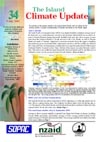An overview of the present climate in the tropical South Pacific Islands, with an outlook for the coming months, to assist in dissemination of climate information in the Pacific region.
Number 34 – 9 July 2003
June’s climate: The South Pacific Convergence Zone (SPCZ) was displaced further south than average east of the Date Line. As a result enhanced convection and extremely high rainfall was recorded over parts of French Polynesia during the month. Rainfall totals were also above average in most areas from the Solomon Islands to Tuvalu and east to the Cook Islands, as well as Pitcairn Island and much of Vanuatu. Suppressed convection persisted along the equator extending from Indonesia across to Eastern Kiribati. Suppressed convection, with low rainfall, also affected Fiji, Tonga and Niue. Air temperatures continued above average throughout much of the tropical Southwest Pacific. Tropical cyclone 'Gina', the last of the season, was active between 4 and 8 June. The storm took a southwest track between the Solomon Islands and Fiji, and then moved southeast to pass over the sea area between Fiji and Vanuatu.
ENSO and sea surface temperatures (SST): The rapid shift in the sea surface temperatures (SSTs) indicating a La Niña like pattern seen in May, did not continue during June. The Southern Oscillation Index (SOI) fell during June to -1.4. The majority of the global climate models indicate that neutral conditions will prevail in the tropical Pacific for the rest of the year.
Forecast validation: How well are we doing with our predictions?
Three month outlook: Average or above average rainfall is expected from Papua New Guinea to Samoa, including Tuvalu, Wallis and Futuna, and Tokelau. Average or below average rainfall is likely for the equatorial region of Western and Eastern Kiribati. Near average rainfall is most likely elsewhere in the region.
Feature article: Is there a role for Indigenous knowledge in improving scientific understanding of future changes in climate?
Sources of South Pacific rainfall data.

A complete copy of The Island Climate Update is available as an Adobe Acrobat PDF file. This does not contain any extra information over that obtained by clicking on the individual items above.
To view the PDF file, you'll need Adobe Acrobat Reader, which you can download free from Adobe.
